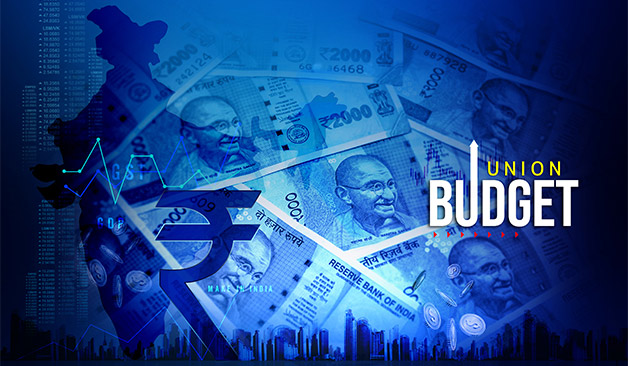
A Budget aimed at generating concentric virtuous circles
As the world economy was thrown off-kilter for two years by a raging global pandemic, fiscal profligacy became the global norm. The US and UK ran fiscal deficits of 14.9% of GDP in 2020 (ending September 2020 for the US, March 2021 for the UK), and 10.9% and 11.7% respectively in 2021.
India, by contrast, remained far more prudent. Despite the severe disruptions cause by the lockdown in March-May 2020, the fiscal deficit for FY2020/21 was 9.2% of GDP – with over 2 percentage points of that represented by past deficits of the Food Corporation of India (FCI) that were moved properly onto the government’s balance sheet. And the deficit for FY2021/22 is officially projected to be 6.9% of GDP, far smaller than those of the US, UK and most of the developed world.
In reality, this year’s deficit is on track to be even smaller. In the first 9 months of FY2021/22 (April-December 2021), the fiscal deficit was only 50.4% of the Budgeted Estimate for FY2021/22, primarily because 96.9% of the budgeted Revenue Receipts had already been received. Normally the January-March quarter is the strongest one for tax revenue, which ensures that the fiscal deficit is smaller in that quarter. For instance, in FY2019/20, the fiscal deficit had reached 132% of the Budgeted estimate for the full year by December 2019, as only 58.4% of the budgeted revenue receipts were received by that month.
The lockdown lopped the final week off FY2019/20, so the fiscal deficit turned out to be 122% of the budgeted figure, as only 91% of budgeted revenue receipts were collected, while nearly 100% of spending occurred. But even in that straitened year, 32% of the full year’s revenue receipts arrived in the January-March quarter. For FY2021/22, the Revised Estimate implies a 36.4% YoY reduction in revenue receipts in Jan-Mar 2022, with only 16.6% of the full-year revenue being collected in that quarter. In reality, at least a 15% YoY increase in revenue receipts will be the likelier outcome for the final quarter (ensuring that about 30% of the fiscal year’s revenue is collected in that quarter), and the fiscal deficit for FY2021/22 will be only 5.6% of GDP.
For FY2022/23, public investment (government’s capital expenditure) is slated to increase 35.4% -- the centrepiece of next year’s Budget – while operating expenditure increases just 0.8%. But the government has conservatively pencilled in nominal GDP growth of just 11% in FY2022/23 – 2-2.5 percentage points lower than its likely growth rate. Tax revenue is slated to increase only 9.6% in FY2022/23, although no important tax reductions will occur next year. In reality, tax revenue should increase 15% or more in FY2022/23, lowering the fiscal deficit to 5% of GDP (much lower than the official projection of 6.4%).
When the actual deficit (and government’s consequent borrowing requirement) is much lower than the official projections, bond yields will decline and help to crowd in more private investment. Bank credit has remained very sluggish over the past 8 years, as the banking system has struggled to overcome the impact of a decade of rampant credit excesses (2004-2014). With an effective ‘bad bank’ now hastening a workout of banks’ NPL burden, and lower-than-budgeted government borrowing likely lowering bond yields, a virtuous circle of strengthening bank credit will spur a crowding-in of private investment to complement the surge in infrastructure.
The infrastructure buildout is focused on the Prime Minister’s Gati Shakti Master Plan, aimed at strengthening synergies and connectivity among roads, railways, airports, ports, mass transit, waterways and logistics. Around 100 new container terminals will be built, the century-long dream of linking five major rivers to mitigate risks arising from unevenly distributed rainfall will begin to unfold -- bolstering irrigation, hydropower, drinking-water access and the use of waterways for commercial transport. To enhance financial inclusion, all post offices will become part of the core banking system.
To alleviate school-children’s educational losses over the past two years, 200 funded TV channels will impart educational content (for classes 1-12) in all regional languages, and a digital university will similarly create educational content for college students. Fibre-optic cable will be rolled out to all villages by 2025, helping to bridge the digital divide. 38 million additional homes will get piped water in FY2022/23, and 8 million new houses will be built next year in tier-2 and 3 cities. These are audacious leaps that continue this government’s remarkable initiatives to roll out world-class infrastructure to India’s have-nots.
The production-linked incentive (PLI) scheme is an East Asia-style initiative to spur an industrial revolution in areas that have previously eluded India: electronics (smartphones, laptops, semiconductors) and labour-intensive industry (larger-scale exports of textiles, garments, shoes, toys and processed food). Next year, the manufacture of solar modules (helped by the goal of reaching 280GW of solar capacity by 2030) and design-based manufacture for 5G (aided by the auction of 5G telecom spectrum in 2022) will join the PLI scheme, already well-funded for pharmaceuticals and large-scale electronics.
India is already the world’s second-largest manufacturer of steel, cement and aluminium, and the fifth-largest car and oil-refining country in the world. But in this slew of sectors, China’s over-capacity has created a global glut, so strategic initiatives to import-substitute are needed. In defence equipment, the share of domestic procurement has risen from 35% in 2015 to 58% in FY2021/22, and is slated to rise to 68% next year – putting India on track to exceed the target of 70% domestic procurement by 2027 set in 2015. PLI and subtle changes in customs duties will spur accelerated industrialisation.
In 2021 (the first year since 2010 in which global trade volume grew more than twice as fast as global GDP), India’s exports outpaced all of Asia, growing 41.6% (much faster than China, Bangladesh, Vietnam, Taiwan and Korea). This Budget will deliver concentric virtuous circles that ensure that 2021 will be a harbinger of more industrial-export success in the years ahead.
By Prasenjit K Basu
_______________________________________________________
Prasenjit K. Basu is Chief Economist at ICICI Securities. The views expressed are personal.
 Invest
Invest



